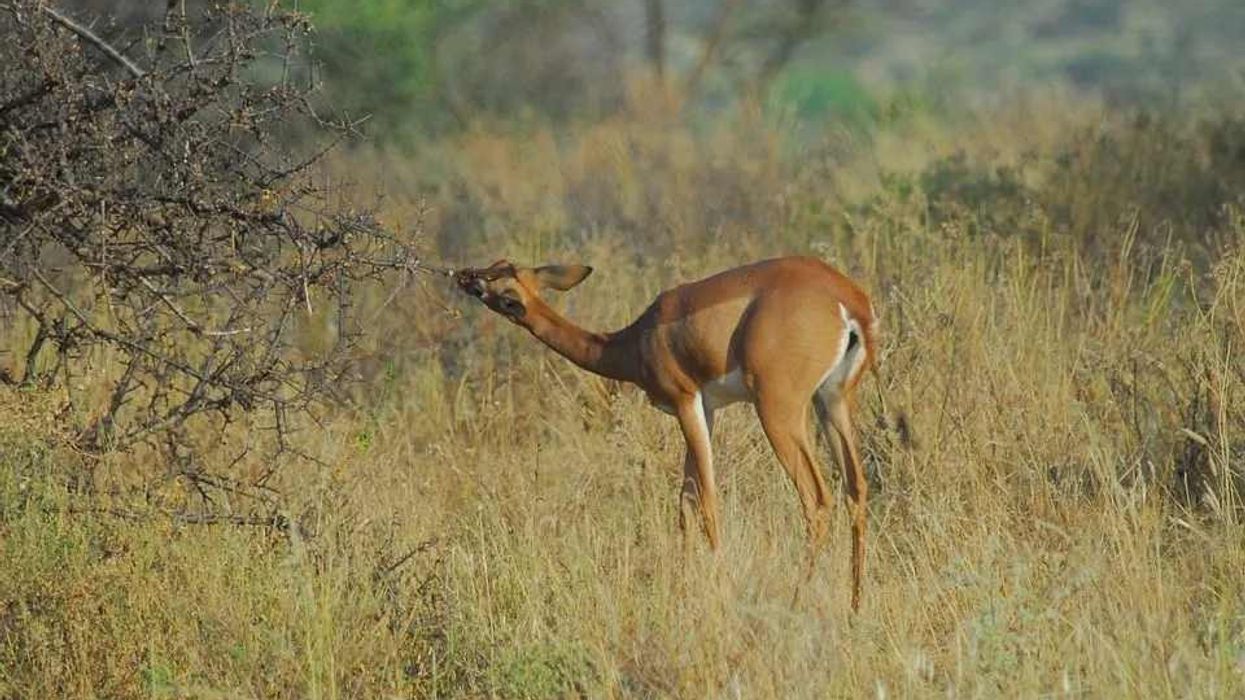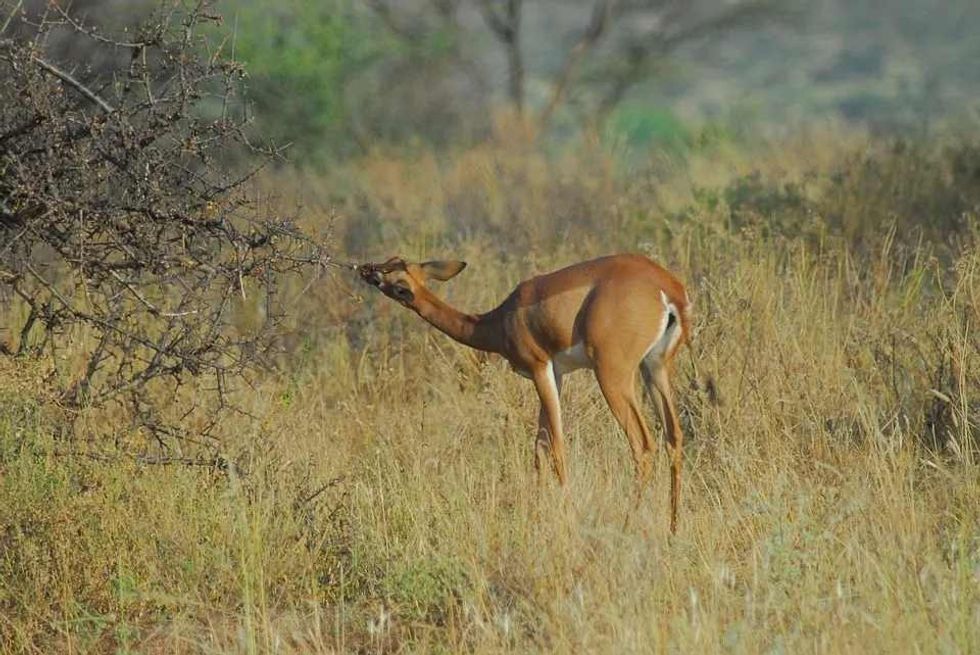Ever wondered how many species there are in this world and how many are still to be found? For once in our lifetime, we all must have pondered over this question.
There are two million species known to us, and millions are still a mystery. On our planet, we can see a variety of beautiful species, and today we are going to learn about one such beautiful species known as the gerenuk (Litocranius Walleri).
This species is found in Africa and resembles a gazelle in appearance though has a slightly longer neck like a giraffe.
The word Gerenuk means 'giraffe-necked' in Somali. Their appearance is so similar to a gazelle that the only differences between them is that the skull of a gerenuk is more solid than a gazelle and an elongated neck as compared to a gazelle.
The Gerenuk is an antelope with a giraffe-like neck. The gerenuk, who belongs to the Bovidae family, is not an ordinary antelope. They have their scent glands on their knees hidden by hair.
These glands are used by them to mark their territory. Are you wondering why?
If yes, then don't worry because this article will tell you all about the gerenuk species. So, without wasting any time, let's look at some of the facts about the gerenuk that also includes gerenuk facts for kids. After, do read our other articles on Alpine ibex and Asiatic lion.
Gerenuk Interesting Facts
What type of animal is a gerenuk?
The gerenuk is a well-known species that has a striking resemblance to a giraffe, and that’s why it is known as the giraffe gazelle. It also has a long neck and comes under the Litocranius genus or Litocranius walleri.
What class of animal does a gerenuk belong to?
A Gerenuk belongs to the mammal class of animals.
How many gerenuks are there in the world?
The gerenuk population has decreased by 25 percent in the last 14 years. There are said to be 95000 gerenuks left in the world. They are near threatened and very vulnerable to being endangered.
Where does a gerenuk live?
Gerenuks are found in the dry parts of Africa, starting from the Serengeti plain of Tanzania, Kenya, Ethiopia, Eritrea, and Southern Somalia. They need not drink water in their lifetime as they can get all the hydration they require from the leaves they consume.
What is a gerenuk's habitat?
Gerenuks make habitats in woody vegetation, dry, flat thornbush, and thickets. Gerenuks usually avoid extreme woodlands and open plains. They have scent glands on their knees that are covered by hair and are used for marking their territory.
Who do gerenuks live with?
Gerenuks live in groups that are not very large. In a group, there are mostly females and their offspring. Adult male gerenuks usually live in solitude. The preferred habitat for this species is woody vegetation.
How long does a gerenuk live?
The average life span of a gerenuk in the wild is eight years, and when in captivity, their life span can extend up to almost 13 years.
How do they reproduce?
Gerenuks reproduce through sexual reproduction. For reproduction, a male gerenuk approaches the female gerenuk, and then the male continuously taps the belly of the female with his foreleg.
The male can also rub the females with his orbital glands in order to accumulate his scent before the mating ritual. Females reach sexual maturity at the age of one year, and males reach the age of sexual maturity at one and a half years. The gestation period of a gerenuk is 204 days.
A female gerenuks give birth to one gerenuk baby calf after a gestation period of around seven months. They generally give birth to only one calf at a time.
What is their conservation status?
The population of gerenuks has heavily declined in past years, and now only 95000 of them are left. These creatures are on the verge of being endangered. Their current conservation status is near-threatened as their habitat is undergoing loss and fragmentation due to human activities.
Gerenuk Fun Facts
What do gerenuks look like?
A gerenuk (Litocranius walleri) is well known for its giraffe-like appearance and enormous, beautiful eyes. A gerenuk is a long-necked antelope whose head is quite small for its size, but the ears and eyes are huge.
The male gerenuks have scimitar shaped horns, which are sturdy and excessively ringed. The males have a more heavily muscled neck than their female counterparts.
The skin of gerenuks has a short fur coat which can be Reddish-brown and Fawn- Buff in color. They have short tails which appear longer because it ends in a bunch of black hair. Just like other gazelles, Gerenuks also have large preorbital glands in front of their eyes.
These preorbital glands secrete a tar-like, scented substance which they leave on twigs and bushes to mark the region of their territory. They also have scent glands present on their knees.

How cute are they?
These antelopes are very cute and beautiful in appearance, plus they are elegant. And if the cuteness of a Gerenuk is to be rated, then it will surely get 10/10.
How do they communicate?
In order to communicate, gerenuks make different sounds such as a buzzing sound when they feel threatened, a whistling sound when they feel irritated, a loud bleat when they are in extreme danger, and a gentle cry when the mothers conversate with their young ones.
How big is a gerenuk?
A gerenuk (Litocranius walleri) is between 4.6-5.3 ft long and around 3.5 ft tall at shoulders. A gerenuk is almost two times bigger than a dwarf antelope. ( A dwarf Antelope is. 2.5 ft tall at shoulders).
How fast can a gerenuk move?
Antelopes can run at impressive speeds, and the same goes for a gerenuk as well. A gerenuk can run at a speed of 40-43 miles per hour.
How much does a gerenuk weigh?
The average weight of a gerenuk is 85-90 lb. Due to its lightweight, it can run pretty fast, and they have good eating habits, which makes them look healthy.
What are their male and female names of the species?
There are no special names for the male and female species of gerenuk, so they are simply referred to as male gerenuk and female gerenuk.
What would you call a baby gerenuk?
A baby gerenuk can be referred to as a calf. The calf remains hidden in the grass to be safe from predators where the mother visits the calf two to three times a day to provide the baby with the milk.
What do they eat?
Gerenuks are herbivores, and they eat parts of plants such as flowers, fruits, buds, leaves.
Are they dangerous?
No, gerenuk is not at all a dangerous animal. They do not pose any threat. Rather they always face a threat of being predated upon and hunted by other big animals.
Would they make a good pet?
Gerenuks are actually not suitable for home life. These animals need free space for their movement and routine activities.
So, keeping them as a pet can be a little challenging. But yes, if you are an expert in handling such animals then you may be a Gerenuk might make a good pet for you. However, the possibility of getting a pet gerenuk is very less.
Did you know...
The gerenuks are not endangered, but their population is near threatened. Their population faced a steep decline in the past two decades. The main reasons for this decline were habitat loss and hunting.
The neck of a gerenuk is 7-11 in long. Their long neck helps them in reaching the top branches of trees very easily.
A gerenuk has some very distinct and useful features which help them in surviving better in their environment.
The gerenuk's survival skills
In order to survive, gerenuks has some distinct features which help them to survive the wildlife. On its muzzles, Gerenuk has big eyelashes with sensory hairs, which allow them to travel safely in thorny bushes.
They have large ears, which help them in detecting the noises of predators. This gives them a great advantage as this enables them to protect themselves before the attack.
Gerenuks can stand on their two hind legs, and this helps them in reaching the higher branches. Their modified lumbar vertebrae, strong hind legs, and wedge-shaped feet make them the only species of antelope, which can stand on two legs.
Their extra-long neck and their ability to stand on two legs help them reach the branches that are 6.5 ft above the ground.
The gerenuks have higher densities in drier areas, especially in the regions that are far from permanent water sources. In this way, they reduce the competition with other browsing animals who are more water-dependent. The gerenuk's diet is enriched with moisture content, and that's why they are able to exploit the inaccessible resources to water-dependent herbivores.
Gerenuks are able to conserve water with uniquely adapted nasal passages. These nasal passages restrict the evaporative loss to a great extent.
Naming the gerenuk
The word gerenuk is a word from the Somali language, which means "giraffe-necked.” Gerenuks have long necks just like a giraffe, and that's why they are also known as the giraffe-necked antelopes.
The word gerenuk should be pronounced as Gae-Rae-Nook.
Gerenuks are the sole member of the genus Litocranius. A Gerenuk is also known as a giraffe gazelle.
Here at Kidadl, we have carefully created lots of interesting family-friendly animal facts for everyone to discover! Learn more about some other mammals including bharal, or Nubian ibex.
You can even occupy yourself at home by drawing one on our gerenuk coloring pages.









